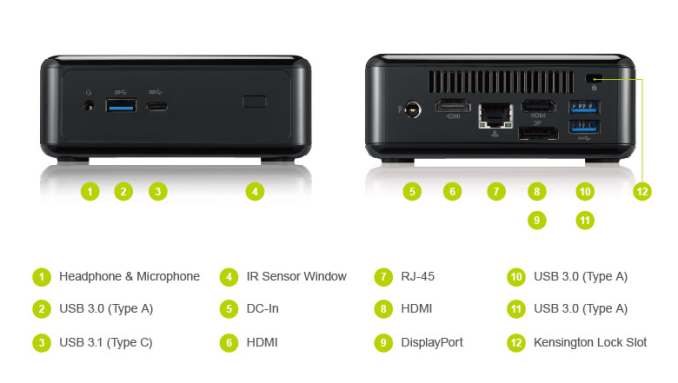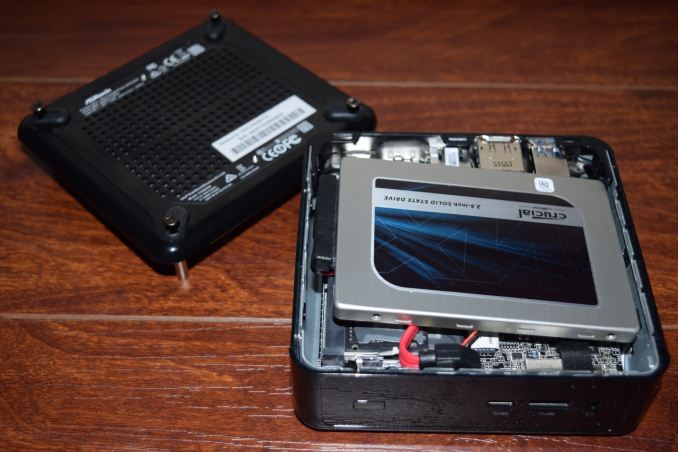ASRock Beebox-S 7200U Kaby Lake UCFF PC Review
by Ganesh T S on February 7, 2017 8:00 AM ESTFinal Words
The benefits delivered by Kaby Lake over Skylake are passable from a performance perspective. That said, the Kaby Lake media engine in the Intel HD Graphics 6xx has moved from lagging behind NVIDIA's VPU to becoming the leader in the space. In addition to HEVC Main as well as Main10 decode support, Intel is also delivering 10-bit VP9 decode. The benefits of the latter are debatable, but, on paper, the Kaby Lake GPU delivers the goods for HTPC users. The MSI Cubi 2 disappointed us a bit on this front by not opting to enable a HDCP 2.2-capable HDMI 2.0 output. This requires a LSPCon (approximately a $2 addition to the BOM according to our industry sources), and ASRock's Beebox-S 7200U integrates one. Kaby Lake's additional DRM capabilities also enable Netflix 4K streaming. All in all, the Beebox-S 7200U is an effective HTPC for casual 4K media consumers - either OTT, or, from local sources.
ASRock also manages to score on some other differentiation aspects - the availability of a USB 3.1 Gen 2 Type-C port, thanks to the ASMedia ASM1142 bridge controller, as well as a compact footprint while retaining support for a 2.5" drive. Unlike some of the other UCFF PCs in the market that opt for Realtek NICs, the Beebox-S 7200U does sport an Intel Gigabit LAN controller.
Positives aside, ASRock still has some scope for improving the Beebox-S. Most of our feedback from the Beebox-S 6200U review are still valid since the chassis design and motherboard components of the Beebox-S 7200U are almost the same (except for the processor and the BIOS).
The internal layout of the unit is very cramped, making even SODIMM installation a bit of a challenge. Installing a 2.5" drive is even more of a pain with the necessity to route the SATA cable and power wires around the SODIMM. While the initial setup issue is a one-time hassle, the effect of the SODIMM heating up on the SATA cable is a bit of a worry. ASRock must shift to a single flexible data/power cable (similar to the one used in the DeskMini 110) to address this issue. Another candidate for addressing is the decision to go with a 1x1 802.11ac WLAN card instead of the 2x2 configuration used by the Intel NUCs.
SATA Wiring Concerns with 2.5" Drives in the Beebox-S 7200U
It is best to use a M.2 2260 SSD in the unit, but, 2280 SSDs are more common. Installing such a SSD is possible, but, requires a separate plastic tab. The M.2 SSD also has no thermal protection support from the chassis design. We also found that the QVL (qualified vendors list) doesn't include many popular NVMe SSDs such as the Toshiba OCZ RD400. Usually, SSDs that are not in the QVL work without problems, but, we found that the Beebox-S 7200U just wouldn't recognize the RD400 in the M.2 slot. To top this, there is definitely some issue with the latest BIOS and the tested Samsung SSD 950 PRO NVMe SSD - the core clocks idle at the maximum rate and the Prime95 torture test occasionally results in thermal runaway and system freezing. Neither of these issues were observed with a 2.5" SATA SSD. Our suggestion to readers contemplating the purchase of a Beebox-S 7300U is to go with a 2.5" SATA SSD instead of a NVMe SSD.
The thermal solution for the processor turns out barely OK - traditional system stability tests keep the temperatures well below Tjmax. However, workloads like Prime95 make the processor enter dangerous territory and the thermal solution can't sustain the 20W package power that the system is configured for. ASRock would do well to make the thermal solution better for the next generation version.
The Beebox-S 7200U is currently available on both Amazon and Newegg for around $350 (though the Amazon first-party listing was backordered when we last checked). The corresponding MSI Cubi 2 and GIGABYTE BRIX models are currently listed at $375 and $391 respectively. Despite the shortcomings that were identified during the course of our review, the Beebox-S provides the best value for money amongst the Kaby Lake UCFF PCs currently in the market.












33 Comments
View All Comments
fanofanand - Thursday, February 9, 2017 - link
Your logic is sound, but most failures don't occur within the warranty period. Sometimes it seems they set the warranty period based on failure rates during QA testing. If they have a 50% failure rate on year 4 they just make sure the warranty is 3 years (oversimplified and inaccurate figures but that's the gist of it). Auto manufacturers have been doing this for decades, there was a reason most powertrain warranties went to 50,000 miles but massive head gasket failures or transmission failures would occur at 60k (I experienced both with GM products which is why they won't be getting any more of my hard earned money).OzzyLogic - Monday, February 20, 2017 - link
It's like you took the words out of my mouth, i really dislike fanned systems because of the dust build up that you will eventually get. No matter what you do, dust will always find its way into your system somehow. Also one of the reasons why i bought my self one of these. https://www.logicsupply.com/eu-en/ml100g-50/thesloth - Tuesday, February 7, 2017 - link
I probably just need to RTFA properly, but I don't see any graphics or mention of noise (dB). For a HTPC I would have thought that relevant.Sene - Tuesday, February 7, 2017 - link
Why don't you test the GPU with MadVR. Even if it has limited power it would be interesting to know the best settings it can supportDavid_K - Tuesday, February 7, 2017 - link
From my testing with a 7700K and its build in HD 630, madVR is just too heavy for the gpu, on 4K videos it becomes a stutterfest.Samus - Wednesday, February 8, 2017 - link
Same experience on my i5-7600k with HD630...only reason I bothered trying was because my 1070 took a week longer to arrive than the rest of the parts. I wasn't optimistic going in but figured I'd see what Intel GPU's can do since I haven't really toyed with one since my 4th gen Haswell laptop.TheinsanegamerN - Wednesday, February 8, 2017 - link
I'm still incredibly dissapointed in intel's lack of improvements in the iGPU race. HD 630 is onyl, on average, 2FPS faster in games then the hd 4600 from haswell.three years and a whole 2FPS, mostly thanks to a better memory controller. Why cant intel start offering more chips with iris graphics?
Raven ridge cant get here soon enough.
BrokenCrayons - Wednesday, February 8, 2017 - link
I haven't really looked into iGPU performance improvements at all since Ivy Bridge's HD 4000. Is that really all we've gained in the past few years out of non-Iris Intel graphics? They've got to be hitting some kind of shared system memory bottleneck that makes it a difficult prospect to wring more out of their iGPUs. Though that doesn't explain the A-series GPUs being fairly quick despite lacking any sort of additional memory bandwidth.nathanddrews - Wednesday, February 8, 2017 - link
There's not much to look into unless you play mostly older games. People are creative and I've seen playable frame rates on non-Iris IGP newer games, but it usually involves 720p resolution and minimal settings or INI hacks to disable engine features. Even the most powerful Intel IGP (Iris Pro) chokes on games like Doom (2016) and Tomb Raider (latest). Context is everything.https://youtu.be/LV8Msa-Pxl8
BrokenCrayons - Thursday, February 9, 2017 - link
Thanks for the response. I'd gotten a vague sense that Intel wasn't really leaping ahead with iGPU performance by the fact that the company's announcements stressed additional features as opposed to "x-times more performance" or "y-percent faster than last gen graphics" but I didn't realize things have gotten so stagnant recently. The fact that Iris exists sort of glosses over and distracts from the much more common eDRAM-less iGPU performance.*rant disclaimer* Iris has really done a lot of damage to the GPU market in general. By raising the bar of iGPU performance to the point where lower end discrete cards are rivaled by Iris parts, Intel's effectively eliminated the low end discrete GPU segment altoghether. At the same time, Iris is an uncommon thing so while the performance exists, it's not available for purchase and there aren't GPUs available to fill the gap between the iGPUs you can actually buy and the bottom end of the current discrete GPU product stack. Thanks for that crap Intel. Thanks a lot for sticking us with the choice of a 75W TDP discrete card or an anemic iGPU that hasn't gotten faster in years.